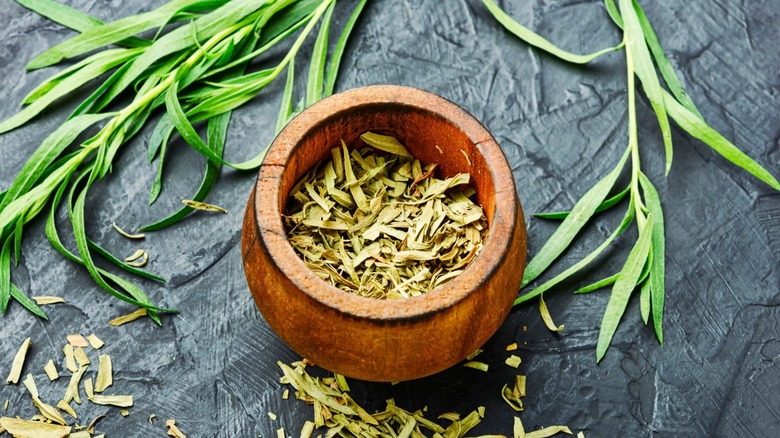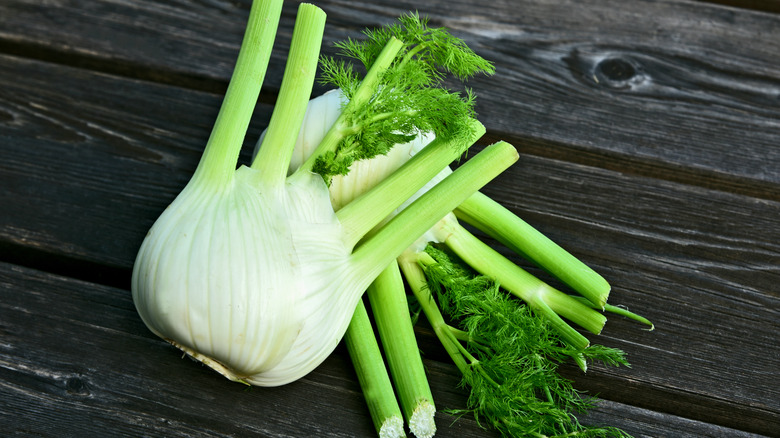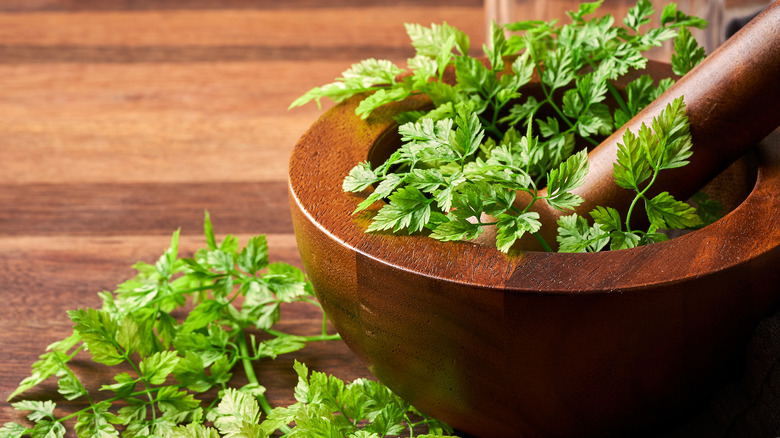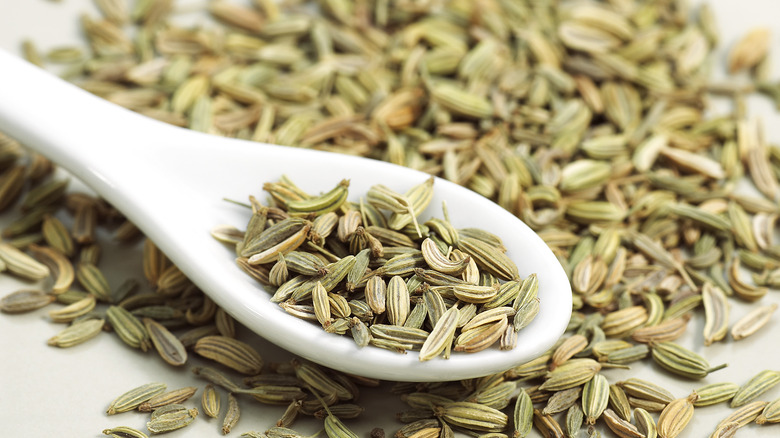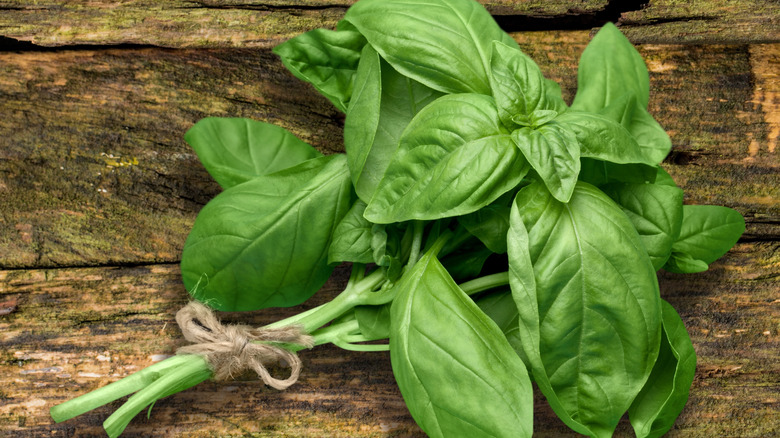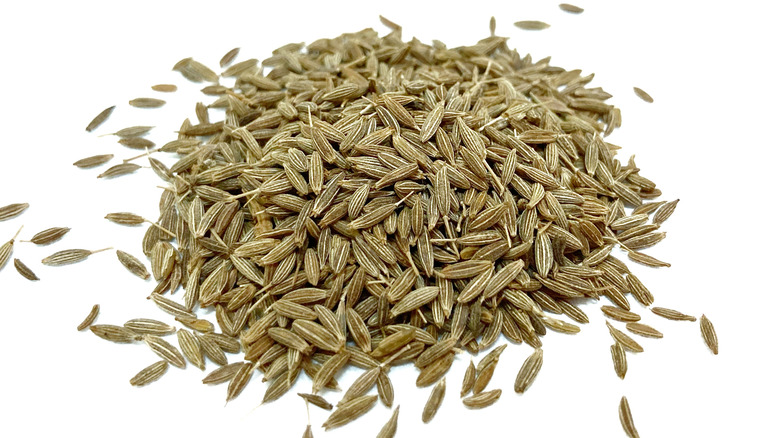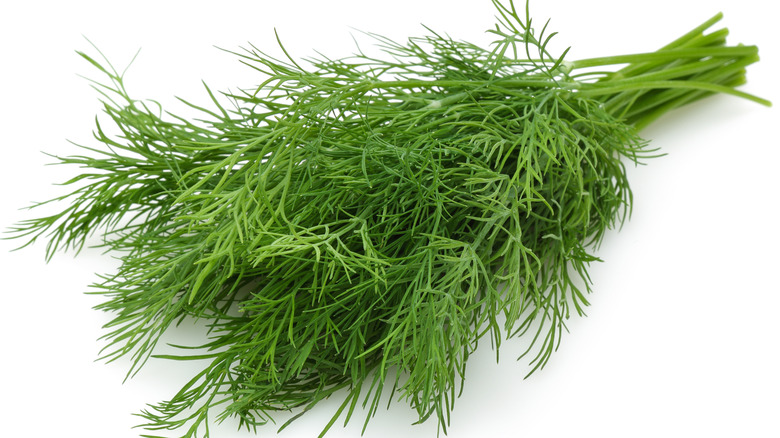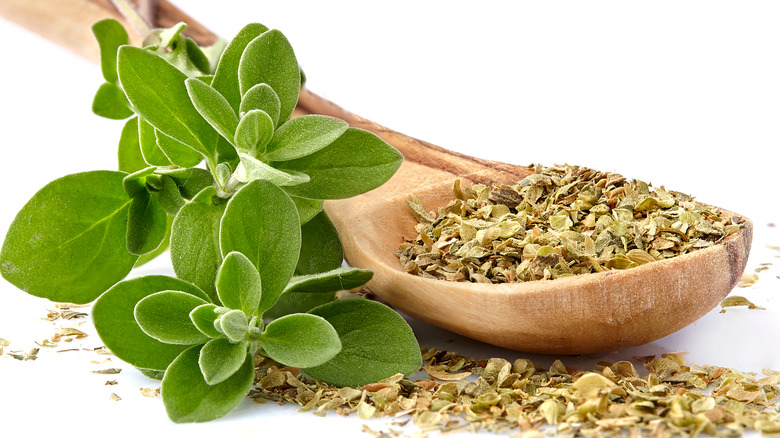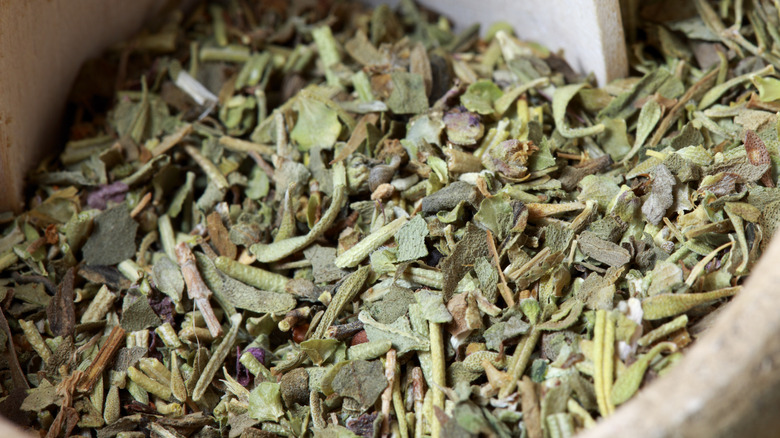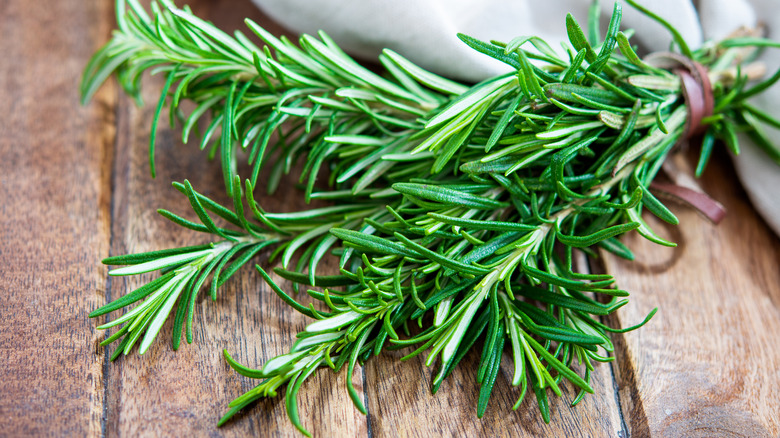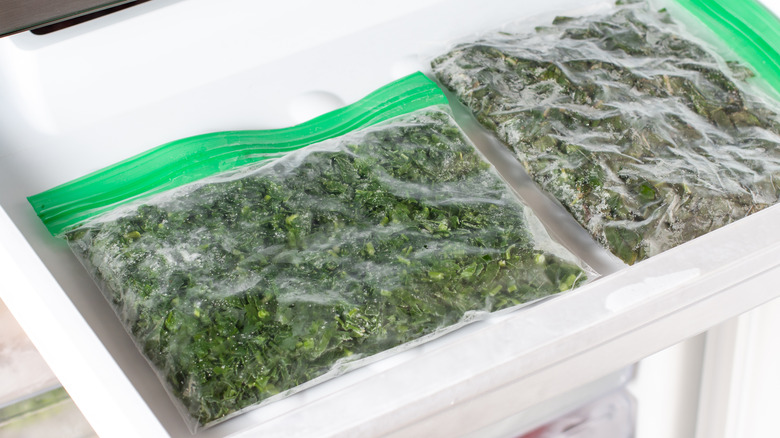10 Best Substitutes For Tarragon
Even among those who grow their own herbs and use them frequently in their cooking, tarragon tends to be a forgotten ingredient. With its intriguing aroma and delicate flavor, tarragon is an herb we should all be reaching for more often in the kitchen. The flavor of tarragon is like that of licorice, but on the milder side. It also has a hard-to-pin-down, fresh quality, with a balance of sweetness and astringency and notes of vanilla and pepper. Tarragon is a component in many French creations, like béarnaise sauce and the fines herbes blend that also includes parsley and chives. It's delicious with fish, chicken, salads, and even flavored vinegar.
Ready to cook with it? Better Homes & Gardens shares that dried herbs can be substituted for fresh: 1 teaspoon of dried for every tablespoon of fresh that's called for in the recipe. However, because tarragon's flavor loses so much complexity in the drying process, many chefs won't use the herb at all unless they can get fresh leaves. In a situation where you have neither fresh nor dried tarragon on hand, other ingredients can stand in. Though these won't perfectly replicate what tarragon brings to the table, these substitutions will still help elevate the flavors in your recipe.
1. Fennel Fronds
If you love the light licorice flavor of tarragon and want a substitute that will bring that same flavor, then fennel fronds are a great choice. Food Network shares that the fennel vegetable grows as a large white bulb with green stems and feathery leaves or fronds. All parts of fennel are edible, and they all have a distinctive licorice flavor.
As is the case with tarragon, the flavor of fennel fronds is delicate and will work best in uncomplicated recipes where they can really shine. Try them in light soups, salads, and homemade dressings. Recipes with citrus (like lemon, orange, and grapefruit) will pair especially well with fennel fronds. The wispy look of the fronds is much like that of fresh dill, so they make an especially great substitute in dishes that call for tarragon as a finishing touch or garnish.
According to Bake It With Love, you should use the same amount of fresh fennel fronds as your recipe calls for of fresh tarragon leaves.
2. Chervil
Chervil is another fresh herb that works well as a substitute when no fresh tarragon is available. If this herb is a little unfamiliar, it's a member of the parsley family, and its leaves resemble those of parsley or carrots (via Gardener's Path). The flavor, too, is similar to parsley, though it also has soft notes of licorice like tarragon.
This herb is often used in French cuisine in dishes with eggs and chicken. Because the flavor of chervil is delicate and easily diminished by cooking, the best use for the herb as a substitute for tarragon is in raw recipes, like salads, or to garnish lightly flavored dishes, such as clear soups. The flavor of chervil can be somewhat subtle, so you can always add a little more to your dish if you think it needs it.
Bake It With Love recommends substituting an equal amount of chervil for the tarragon in your recipe, then doing a taste test.
3. Fennel Seeds
Not only are the bulb, stems, and leaves of the fennel plant edible; the fragrant seeds are, as well — and they can stand in as a substitute for tarragon. EatingWell shares that fennel seeds are oval-shaped, greenish-gray in color, and have a sweet taste and anise-like flavor. In fact, they're often confused with anise seeds. Though both ingredients are known for their licorice quality, fennel seeds are milder in flavor overall.
The Kitchn notes that fennel seeds can be used in ground form, or the whole seeds can be cracked slightly to release the flavor compounds inside. In either form, fennel seeds have a much stronger flavor than tarragon, according to Bake It With Love. The flavor works well in sausage recipes, as well as with fish. The seeds can also be used as a seasoning in soups and to flavor salad dressings.
To substitute fennel seeds for tarragon, use only ⅛ teaspoon for every tablespoon of fresh tarragon called for in the recipe.
4. Basil
When looking for another fresh herb to use in place of tarragon, basil leaves are another excellent choice. This substitute is usually easy to find in packages or pots at the grocery store, and you may even have tried growing basil in your window garden. Of course, the flavor of fresh basil is not identical to that of tarragon: MasterClass describes it as "sweet and savory, with hints of mint, anise, and pepper." Those anise notes will deliver some of the characteristic licorice flavor found in tarragon. While the licorice taste is minimal in Genovese basil, you can find more of an anise quality in a Thai variety called licorice basil, per Gardening Know How.
Depending on the dish you're making and how much you like the taste of basil, it's best to start with an equal-parts substitution for tarragon, then taste your dish to see if it needs more herbaceous notes.
5. Anise Seeds
In recipes where you need to replicate the licorice flavor of tarragon leaves, but a fresh herb isn't necessary, dried anise is the substitute to reach for. Taste of Home shares that anise seeds are small, brown seeds that look similar to fennel seeds. (They're not to be confused with star anise, round seeds inside a star-shaped pod that are commonly used in Chinese cooking.) Anise seeds will bring a very licorice-forward flavor to your recipe.
Because anise seeds are hardier than delicate fresh herbs, they're especially effective as a tarragon substitute in cooked dishes like soups, braised meats, and sauces. You can choose from ground varieties or use whole seeds, which can be lightly toasted before cooking to enhance their flavor.
Because the flavor of anise seeds is so strong, Bake It With Love recommends using only a pinch to replace every tablespoon of fresh tarragon leaves or teaspoon of dried tarragon.
6. Dill
In addition to imbuing dishes with an intriguing flavor, fresh tarragon offers a beautiful dash of color and texture when used as a garnish. If you're looking for a tarragon substitute with similar appeal, consider picking up a bunch of fresh dill. With its vibrant green color and feathery leaves, dill is easy to snip over the top of your food for a pop of color. The leaves are also extremely fragrant, with a bold taste that's "grassy." Dill will certainly add an appealing flavor and aesthetic quality to your dish, but it only has a hint of the licorice flavor found in tarragon. To fix that, you could use dill in combination with another herb that has licorice notes, like Thai basil or chervil.
When using dill as a substitute for tarragon, A Couple Cooks recommends a 1:1 swap, whether your recipe calls for dried or fresh.
7. Marjoram
While marjoram doesn't have the licorice flavor of tarragon, it does have a complex and delicate taste, which makes it a wonderful substitute in a pinch. Per MasterClass, leaves of fresh marjoram are small, oval-shaped, and fuzzy. Because the two green herbs look similar and are distantly related, marjoram is often confused with oregano, but its flavor is actually pretty different: sweeter and milder, with hints of citrus, pine, and flowers. The fresh variety can be hard to track down in stores, but dried marjoram is easier to find in most spice aisles. Try the herb in meat dishes, with vegetables, or in seasoning blends for chicken and turkey.
When using fresh marjoram as a substitute for fresh tarragon, incorporate an equal amount of leaves. If dried marjoram is all that's available, Marvelous Chef recommends using 1 teaspoon in place of every tablespoon of fresh tarragon, or an equal amount as your recipe calls for of dried tarragon.
8. Herbes de Provence
In recipes that call for dried tarragon (or those in which a dried herb will not negatively affect the final dish), the spice blend known as herbes de Provence is an excellent choice as a substitute. The exact herbs used in the blend vary from brand to brand, but Taste of Home says that it typically includes thyme, marjoram, rosemary, and basil. Some add other dried herbs, like tarragon, parsley, and chervil. Even if tarragon is missing from your herbes de Provence blend, things like parsley, chervil, and basil will still lend licorice notes to your dish. Use the blend whenever you're cooking something inspired by the region in southern France, from Julia Child's French omelette to roast chicken with potatoes.
Try a 1:1 ratio when substituting herbes de Provence for dried tarragon.
9. Rosemary
Like basil, rosemary is available in most grocery stores, which alone makes it a convenient substitute for tarragon. With deep green, needle-like leaves that grow on woody stems, according to SPICEography, fresh rosemary is highly aromatic and has a sharp flavor of pine, pepper, and citrus. If your recipe is French in origin or influence, then rosemary may be a great fit; the Auguste Escoffier School of Culinary Arts says that along with tarragon, sage, and parsley, rosemary is frequently used in French cuisine.
Even when dried, the herb retains a great deal of flavor and aroma. In fact, as Cook's Illustrated notes, dried rosemary is even more potent than fresh; unlike delicate herbs, hardy herbs do not lose as much flavor during the drying process. This means that both dried and fresh rosemary can be used in place of tarragon in recipes — just use extra if you're planning to cook with the fresh variety since it will not be quite as strong.
Marvelous Chef recommends using 1 teaspoon of dried rosemary for every tablespoon of fresh tarragon called for in your recipe.
10. Frozen Tarragon
Tastessence reminds us that frozen tarragon leaves can be substituted for fresh leaves and used straight from the freezer in recipes. Best of all, the herb retains its flavor when preserved this way. This is a great tip if tarragon is a hard-to-find ingredient where you live: When you do come across a fresh bunch at the store, from a local grower, or at the farmers market, you can freeze the leftovers to have on hand for another time.
When freezing herbs, the first step is to wash them, according to SPICEography. You can also blanch the tarragon (give it a quick plunge in boiling water, followed by ice water) to help soften it and preserve its color. Squeeze out any excess water, then layer the tarragon into several small, air-tight bags that will go into the freezer; this makes it easy to retrieve only what you need instead of defrosting all of it at once. You can also freeze the tarragon with water in an ice cube tray. Since it will be very soft after it thaws, it's best when used in dishes that require cooking, like soups and sauces.
Use the same amount of frozen tarragon as your recipe calls for of fresh. If you're substituting for dried tarragon, Martha Stewart's site recommends using 1 tablespoon of fresh herbs for every teaspoon of dried herbs called for in your recipe.
